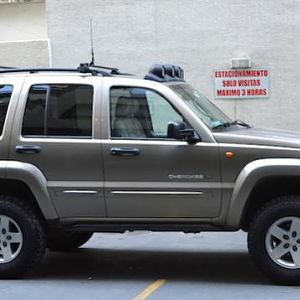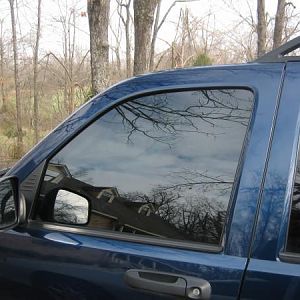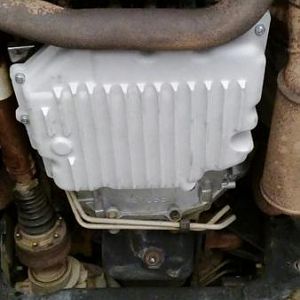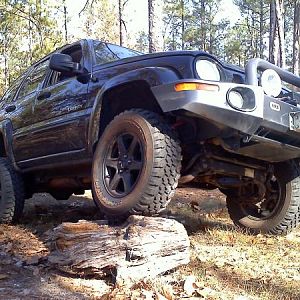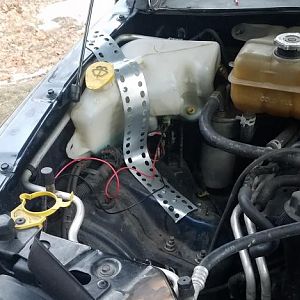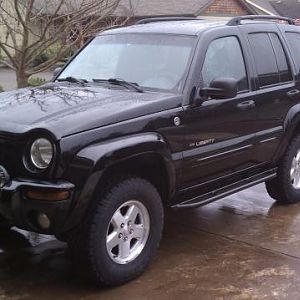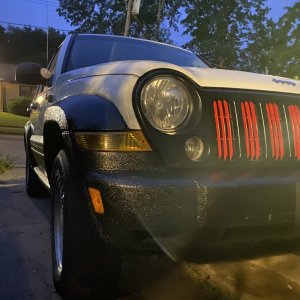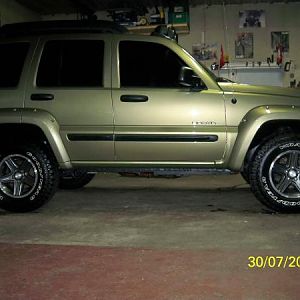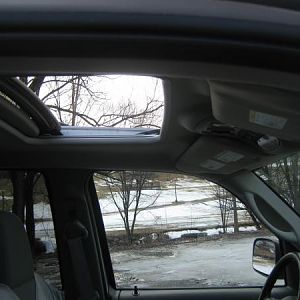Hmmm. Lets see, how to get into this...
Let's start with the back, because that's a piece of cake. Yes, we lengthen the shocks when we install taller springs so that:
We don’t extend the old, shorter shock to its max when the suspension is in full droop.
We install a taller bump stop so that:
We don’t fully compress the new longer shock (that is in the shorter shocks same position) when we are in full bump, i.e., compression. It's more desirable to limit in this way than lowering the bottom mount any more than it already is.
By doing this we have increased the range / travel of the system while increasing the ride height of our vehicle. Which is good, that's what we want.
Now the front of the vehicle.
Ideally, we would like to do the same exact thing. Increase the travel of the system while raising the ride height. Agree?
TwoBobs you eloquently defined the problem in one sentence, "The front SHOCKS are the same length whether your Jeep is lifted or not."
There are simply no struts available other than those that are the stock travel length. Let's talk travel only at this point. The Rancho's and other stock replacements like NAPA, seem to have a travel of 4.25 inches. The OME's are at 5.2". For the life of me I cant find a Bilstein spec sheet anywhere, so I don't know where they are at. Somewhere in that range no doubt.
I think this is going to be long and painful, please bear with it. The scattered thoughts will eventually come together.
Let's design a suspension. For the time being let's not worry about the upper A arm / spring contact and look the other limiting factor, the max lift we can put on the CV joint axle and not have it bind up.
This is why I was asking the question about the max droop you guys had after your lift. I guess I'd just try to measure it, but I'm on the road in a hotel for the next few days. Let's make an educated guess of 5 inches.
You must be registered for see images
I did some measuring and it seems fairly accurate that the distance from the lower control arm frame axis to the ball joint is 16", and the strut is located 6" from the ball joint. This sets up a ratio at 16/10, or a 1.6 factor for force and distance calculations at the wheel vs. the strut. (I've seen a factor of 2 all over the forum).
So with that factor, when the axle displaces 5", so does the ball joint, and the strut displaces 3.125"
You must be registered for see images
That's a total of 6.25" travel at the strut. But remember... the LONGEST travel strut available was 5.2". This makes sense really; we assumed the 5" up and down. No manufacturer on earth would design their suspension to go right to the limit of the CV joint.
But we want to

We just cant do it, because 5.2 is the biggest. That equates to 8.32 inches of travel at the wheel:
You must be registered for see images
You must be registered for see images
So where are we? We want to get THE MOST lift possible out of this situation that we can right? So lets design the bottom (extended) range of the strut to correspond to the max deflection of the CV joints. In this case 5".
RIGHT NOW it is not our concern as how to LOCATE the strut there. That can be achieved with shims / spacers at the top of the strut or "clevis" lift as you've termed it.
Or things like this:
You must be registered for see images
Since we only have 8.32 inches of travel at the wheel available instead of the full ten, we get something like this:
You must be registered for see images
That kinda *****, but it gets worse...
From what I can see, the axle shaft between the two CV joints is pretty much horizontal for a stock ride height. Let's assume it is.
We want to design a ride height 2.5 inches above stock. After all that's the name of this thread right?
Here you go:
You must be registered for see images
Now to the math. Let's define "Wfw" to be the weight on the front wheel and "Wfs" to be the ‘weight’ on the front strut. They are related by a factor of 1.6.
Wfw x 1.6 = Wfs
From what I can find (and why I was asking) is that a stock kj curb weight is 4115 pounds with a distribution of 53% front and 47% rear. That comes out to 1090#'s at one front tire. Let's say we have a big bumper and maybe a winch and some lights and other $hit hanging off the front. Maybe 180 or 200 pounds worth. AT THE FRONT axle, that weight is amplified a little bit because of the fulcrum. Let's say it's pressing on the struts/springs with 265 pounds or 132.5 pounds each side. That's not unreasonable, and the reason for such odd figures will be apparent.
Now lets use the recommended strut and spring combo:
OME's NS-131 strut with 5.2 inches travel, and an extended length of 333mm or 13.11 inches.
OME's #927 spring, with a 400#/inch spring rate (after all we have a big bumper and winch!) and an uncompressed length of 394mm, or 15.5 inches.
(15.5"-13.11") x 400#/inch = a strut preload of 956 pounds.
We said the jeep weighed 1090 plus 132.5 pounds at each tire, or 1222.5 pounds. Multiplying by 1.6 to get the "weight" at the strut yields:
1956 pounds force, provided by the spring/strut to support the vehicle. So factoring out the preload of 956 pounds, we will need to displace the spring SOME DISTANCE such that the force required to do so will be 1000 pounds. That's at the strut.
That's easy math, 1000 pounds, 400 pounds per inch, 2.5 inches! Cool right? That's our lift? Not quite, that 2.5 inches is displacement at the STRUT. That means 4 inches at the wheel. Turns out it's only a 1 inch lift kit.
But hey, we can fix that with shims and plates and "clevis"! (Yes there's a slight error in the math here... you guys are only adding .325" of top shim and .325 of clevis offset for .75 inches at the strut, not the .94". [.94 inches x 1.6 is 1.5" at wheel, plus the 1" is a 2.5" lift] So the math is off by .18" but remember... we assumed that the stock ride height equated to an exactly horizontal axle. At least I think that's what is causing the inconsistency!)
So that's what we do. We offset the strut to give us the lift we want, with the given weight and spring rate of out truck.
Now lets look at the real problem with this.
The strut is displaced 2.5 inches to provide the required force to lift the vehicle weight. There is only 5.2 inches to start with, so that leaves us with 2.7 inches left to displace before the strut hits the stop (and I don't even think it has an internal stop at that end.) That 2.7 inches at the strut equates to 4.32 inches at the wheel.
What you end up with is a limited range that looks like:
You must be registered for see images
And the bottom 2.5 inches is only available in droop. (like if you jacked up your jeep from the 'frame' and let it the wheel hang.)
Now it is a sound design with respect to things like... getting your lift where you want it, Not busting a CV, supporting your cool winch, etc. And don’t get me wrong, it will feel great to drive around, responsive with limited body roll. But it's akin to putting blocks under an indy car. It's really stiff and responsive, and it's really high.
By the way if our strut is shorter than the 5.2 inch OME, it reduces the usable travel EVEN FERTHER!
God that was long. I sure hope my math is good and I'm not just spraying a bunch of $hit. It begs the question though:
What should we do now?
You must be registered for see images
Well we need is a strut with full travel. Let's say we could find one. 6.25" minimum if we really do have 10 inches (5 up and 5 down) of usable axle displacement. We can still preload a 400 pound spring 2.4 inches to yield 956# and add 2.5 inches of displacement to arrive at 1956 pounds force at the strut, which will hold us at 2.5 inch lift, but the spring is going to have to be longer. And we are going to have to fab up the mounting for it.
I haven't done the math on this but I suspect that a strut with an even longer displacement could be used with a lower preload and weaker spring if it were mounted more compressed. Of course that would take away the lower bump stop that limits the system extension. Gotta figure that out I suppose.
So this is the impasse. Has anybody cracked this code? Gotten full travel out of their lifted IFS? I haven’t found a strut like I'm thinking this needs yet. Although a strut cartridge like this might have potential:
http://catalog.monroe.com/catalogPa...CTIVE&locale=en&methodName=displayPartDetails
It would require fabricating some sort of clevis and spring seat though. Not to mention poke out the top mounting a bit, a mounting that will have to be fabricated.
Thanks for reading tonight's novel. Next chapter: Roll Centers.
.


